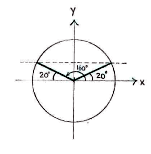Solution 4.3:9
From Förberedande kurs i matematik 1
Using the formula for double angles on \displaystyle \sin 160^{\circ} gives
| \displaystyle \sin 160^{\circ} = 2\cos 80^{\circ}\sin 80^{\circ}\,\textrm{.} |
On the right-hand side, we see that the factor \displaystyle \cos 80^{\circ} has appeared, and if we use the formula for double angles on the second factor (\displaystyle \sin 80^{\circ}),
| \displaystyle 2\cos 80^{\circ}\sin 80^{\circ} = 2\cos 80^{\circ}\cdot 2\cos 40^{\circ}\sin 40^{\circ}\,, |
we obtain a further factor \displaystyle \cos 40^{\circ}. A final application of the formula for double angles on \displaystyle \sin 40^{\circ } gives us all three cosine factors,
| \displaystyle 2\cos 80^{\circ}\cdot 2\cos 40^{\circ}\cdot\sin 40^{\circ} = 2\cos 80^{\circ}\cdot 2\cos 40^{\circ}\cdot 2\cos 20^{\circ}\sin 20^{\circ}\,\textrm{·} |
We have thus succeeded in showing that
| \displaystyle \sin 160^{\circ} = 8\cos 80^{\circ}\cdot \cos 40^{\circ}\cdot \cos 20^{\circ}\cdot\sin 20^{\circ} |
which can also be written as
| \displaystyle \cos 80^{\circ}\cdot\cos 40^{\circ}\cdot \cos 20^{\circ} = \frac{\sin 160^{\circ}}{8\sin 20^{\circ}}\,\textrm{.} |
If we draw the unit circle, we see that \displaystyle 160^{\circ} makes an angle of \displaystyle 20^{\circ} with the negative x-axis, and therefore the angles \displaystyle 20^{\circ} and \displaystyle 160^{\circ} have the same y-coordinate in the unit circle, i.e.
This shows that

